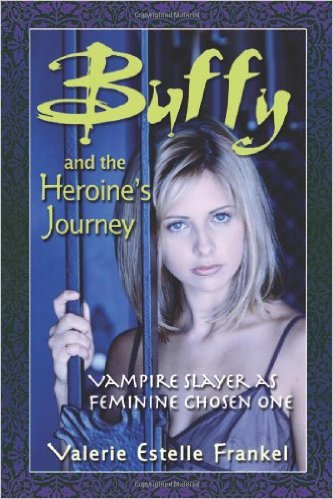Buffy and the Heroine’s Journey: Vampire Slayer as Feminine Chosen One

Buffy and the Heroine’s Journey: Vampire Slayer as Feminine Chosen One. Valerie Estelle Frankel. Jefferson NC: McFarland, 2012. 226 p. 9780786467921. $35.00.
Reviewed by Janet Brennan Croft
[This review originally appeared in Mythlore 31.1/2 (#119/120) (2012) : 191–193.]I reviewed Valerie Estelle Frankel’s From Girl to Goddess: The Heroine’s Journey Through Myth and Legend (McFarland 2010) in Mythlore 115/116; in that volume, Frankel explored the ways in which the journeys of female characters in folklore, myth, and legend differ from the well-known male model as described by Joseph Campbell. In her words, the female journey is one of “cleverness and intuition […] birth and patience […] destroying mountains and creating civilizations” (10). While it shares the basic overall structure of the male journey—separation, initiation, and return—different challenges confront the female hero at many stages; for example, where the male hero at his nadir meets the goddess and confronts the woman as temptress, the female weds her animus and faces Bluebeard, the murderous husband. The female path tends to be more spiral than strictly circular, working through the journey over again at higher levels.
In Buffy and the Heroine’s Journey, Frankel applies her theoretical structure to Buffy the Vampire Slayer, from the original movie through the seven television seasons and the eighth comic book “season,” with occasional forays into the crossover episodes of Angel. One of Frankel’s first key insights is that Buffy’s path is not just spiral but fractal; inside the full arc of the series are the shorter multi-year high school and post-high-school arcs (with the newer multi-Slayer era arc beginning in the comics), the arc of each individual season, the arc of each individual episode; each its own heroine’s journey in miniature as Buffy repeatedly dives into hell, faces the demons, and saves the world. “A lot.” As with Frankel’s earlier book, I find her charts enormously helpful in presenting her ideas; this one starts with a chart of her general comparison of the hero’s and heroine’s journeys, then follows with a chart mapping the stages of the heroine journey onto Buffy’s season 1-3 and 4-8 arcs. Later charts list Buffy’s enactment of the major feminine archetypes in these same arcs, showing who or what represents the associated Shadow and Animus figures for each archetype.
The text itself does not methodically work through these charts, letting them stand on their own as a broad guide to the territory, but instead is a wide-ranging Jungian reading of the stages in Buffy’s journey and her helpers and adversaries at each stage. For example, Frankel points out the significance of the gender of the “Big Bad” for each season, as Buffy struggles against patriarchal enemies in the early seasons (The Master, Angelus, the Mayor), then Terrible Mothers (Maggie Walsh, Glory), and more nuanced, diffuse, or internal evils in the end (the return to the mundane world and the banality of the Trio, the despair engendered by the First and the temptations of power, the tyranny of her own goddesshood in Season Eight). Examining the interplay of Shadow, Animus, Anima, and other archetypes surrounding each of these challenges adds depth to our understanding of Buffy and her friends—and part of the strength of the series is that Buffy’s friends act not just as aspects of her own self, but are characters on their own journeys at the same time. (Willow’s and Faith’s journeys in particular are closely examined.)
Frankel has a keen eye for the visual aspects of the show, not just the words of the dialogue and the commentary; setting, color, music, symbolism, visual and aural echoes of earlier scenes, and even costume are all given their due as elements reinforcing the story. Her wide familiarity with folktale and literature leads to many interesting comparisons; the book is liberally salted with references to The Wizard of Oz, King Lear, Gone With the Wind, The Lord of the Rings, and many other sources, in addition to the key scholarly sources on Buffy itself. As with From Girl to Goddess, I found myself highlighting the extensive bibliography nearly as often as the text itself.
The book is most useful as a guide to a re-viewing of the series; a reader unfamiliar with the episodes and characters will not find this a good introduction, but for the viewer who wants a wise guide back through the darker inner circles of the Buffyverse, this book is an admirable Virgil.

